 | ||||
CHAPTER III - Matrices and the Reality of Sainthood
_______________________________________________________________________________
II – Matrices and the Reality of Sainthood
1 – What Are Matrices?
In order to solve a set of linear equations, one proceeds by using a system called matrices. Matrices are arrays of numbers representing the coefficients of a linear system’s equations.
Here are some examples of matrices:
In the Holy Name of God, the All-Compassionate, the All-Merciful,
With peace and blessings upon His Prophet Muhammad SAW
upon his holy family, and upon his blessed Companions.
THE PRINCIPLE OF ETERNITY
Bridging the Gap between Spirituality and Science
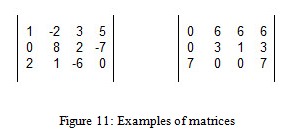
Matrices have different spiritual meanings that vary depending on the level of interpretation of the seeker. In linear algebra, they are the manifestation of the reality of sainthood.
2 – From Knowledge of God to Knowledge of His Friends
“Who knows himself knows his Lord.”
Man arafa nafsahu faqad arafa Rabbahu
Hadith
This saying implies that knowledge of the part (reality of the human self) will lead to knowledge of the whole (reality of God). Hence, by establishing a connection between matrices and the saints of God who are the ones who unlocked the knowledge of their true selves, one may better understand the science of linear algebra as it pertains to the knowledge of God.
3 – Analysis and Interpretation of Matrices
a – The Echelon Form
When we are given a matrix, we try to solve it by reshaping it into a particular mathematical form called the echelon form. The matrix has to follow a set of mathematical rules in order for it to be in the echelon form. These mathematical rules are critical in solving the system of equations the same way the spiritual rules of a spiritual path are critical in reaching the level of knowledge of God. Here is an example of a matrix in the echelon form:
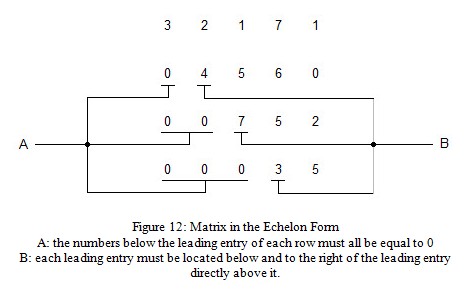
The idea behind the echelon form is to have 0’s under each leading entry of the matrix. Also, each leading entry must be in a row below another leading entry and to the right of that leading entry so that the matrix looks like a step-like pyramid, thus the name “echelon form”. The properties of a matrix in the echelon form are as follows:
- Property 1: all entries in a column below a leading entry are zeros
- Property 2: each leading entry of a row is in a column to the right of the leading entry of the row above it.
- Property 3: all nonzero rows are above any rows of all zeros (since such a row is null, it may be deleted from the matrix).
b – Pivots and the Saints of God
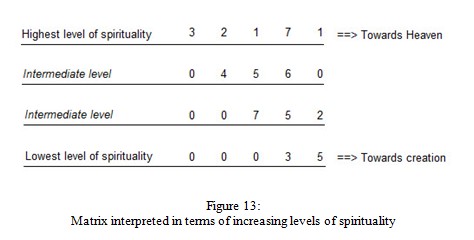
The three properties of the echelon form mentioned earlier are the manifestations of some of the spiritual rules pertaining to the reality of sainthood. Let’s take interpret them in a spiritual context.
Interpretation of Property 1: All entries in a column below a leading entry are zeros
Interpretation of the two other Properties
“Above each possessor of knowledge there is one with more knowledge.”
Holy Quran
c – The Existence Theorem
0 0 0 0 0 6 or 0 0 0 0 0 7
The Lowest Pivot and the Saint Connected to Creation
The pivot in the last row of the matrix represents the saint who is among society and who connects creation with the higher saints who are in the Divine Presence.
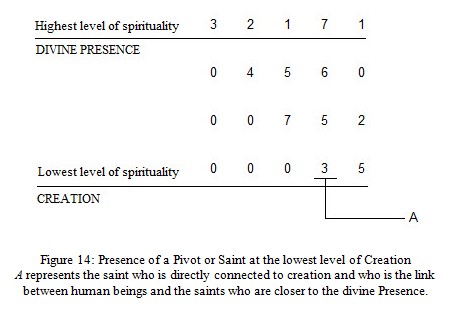
As we see from the matrix, in spirituality, all those who follow the guide of a spiritual path (the columns of the matrix) exhibit signs of complete non-existence (the zeros in the columns). Moreover, the existence theorem guarantees the presence of a saint among a community who establishes a link between the community and the higher saints who are in the Divine Presence.
The Notion of Divine Representation and the Role of Adam
This pivotal nature is expressed in the following Verses:
Then man became a blood clot, then God shaped his body
and fashioned him in due proportion.
Holy Quran 75:38
and
“We have honored the sons of Adam”
Holy Quran 17: 70
and
“We taught him knowledge from our divine Presence”
Holy Quran 18:65
No Solution Systems
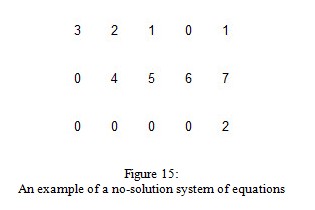
One may see that there is no pivot in the last row of the matrix (excluding the rightmost entry since this entry does not represent the unknown variable of an augmented matrix). Therefore such a system has no solution.
d – The Uniqueness Theorem
The uniqueness theorem of linear algebra stipulates that the set of solutions of a system of equations contains a unique solution when there are no free variables. Conversely, the matrix has an infinite number of solutions when there is a least one free variable. Therefore, the presence of free variables determines the uniqueness of the solutions of a matrix.
What are Free Variables?
In a matrix, a free variable appears when the entry directly below and to the right of the pivot above this entry is zero. Usually this leading entry is a pivot but since it is null in this case, the variable the entry is representing becomes “free” to assume any value.
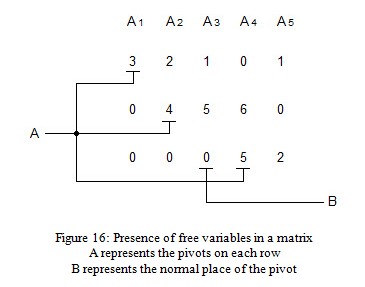
In the figure above, the 3rd pivot should be below and to the right of the 2nd pivot (4). However, since this 3rd entry is actually null (0) the next entry (5) assumes the role of pivot and the variable A3 is said to be free.
Spiritual Interpretation of Free Variable: the Station of Union
“What can I say about the stations of those who have attained union
except that they are infinite, while the station of the travelers have a limit?
The limit of the travelers is union. But what could be the limit of those in union?
– that is, that union which cannot be marred by separation.
No ripe grape ever again becomes green
and no mature fruit ever again becomes raw.”
Rumi, Fihi ma Fihi 122-123/132-134
and
“When Shams-I Tabrizi becomes our guest,
We are multiplied hundreds of millions of times!”
Diwan, 1767
and
“One moment I am the sun, the next an ocean of pearls.
Inwardly I have the majesty of the spheres, outwardly the lowliness of the earth.”
Diwan, 1426
Shams-I Tabrizi is Rumi’s spiritual master and as such represents the pivot that is higher in spirituality and closer to the Divine Presence. In these verses is displayed the nature of free variables which are infinite and eternally changing. Rumi’s mention of the “outward lowliness of the earth” is the outward form of the pivot that has attained union and that is manifested in the matrix as the number 0 which is the ultimate form of lowliness.
The infinite number of solutions of a matrix is consequently a manifestation of the infinite number of manifestations of divine Attributes a true saint can exhibit. Farid-ud-Din Attar (1145-1221), one of the most important figures of Islamic history, commented on this topic by relating a story from Aba Yazid al Bistami (804-874), another great saint of Islamic history:
“Some people asked Bayazid to describe the divine Arch. He answered: “it is me”. And what about the divine footstool? they asked. He answered: “it is me also”. Then they asked him if there was someone who was comparable to the prophets Abraham, Moses, Jesus Christ and Muhammad; he answered: “yes, there is me”.
Then they asked him if there was someone who was comparable to the archangel Gabriel; again he answered: “there is me. And the one who has reached God and the station of union, whatever he says must be the truth.”
Farid’ud-Din Attar, Le Memorial des Saints, p.177